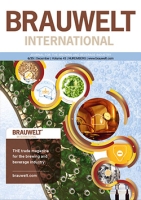At the beginning of 2001, in the context of modernising sections of the brewhouse at Binding Brauerei AG in Frankfurt am Main/Germany, Centec GmbH supplied and commissioned novel sensors based on ultrasound measurement. The innovation relates to the fact that both extract concentration and flow are measured simultaneously. A profibus is used for data transfer. The present contribution describes the concept and advantages of the new system.
Low-pressure external heating units are usually mentally associated with mechanical vapour compression. Thermal vapour compression of vapour from boiling with high-pressure live steam is an alternative as at a low steam pressure, the live steam portion and thus condensate losses associated with this live steam portion may still be acceptable.
These and other general aspects which have to be considered in addition are dealt with in this article and should be taken into account in the decision-making process.
Mechanical vapour compression
Mechanical vapour compressors compress vapours from wort boiling to 0.35 to 0.5 barg, whereby the higher compression pressure calls for an over-proportional higher power draw compared to the lower compression pressure.35 and 0.e....
The authors of this article have been working in the brewery engineering sector for several decades now and are owners of many patents that have delivered energy savings in breweries. As a result of many investigations and consultancy opportunities, it has also been possible to save considerable amounts of primary energy. The following article describes possible options, and the results that could be obtained by their application. It has been written with the primary aim of stimulating the American market, but is also of value to anyone interested in saving energy in breweries.
Europe many people were amazed to learn earlier this year that the USA was in the grip of an energy crisis. It forced us to take a serious look at ways to save energy, both generally and in specific areas..
The decision of a brewery to use a particular optimum process is dependent on a number of important criteria. These include purchase costs, space requirements, process flexibility, operational and consumption costs, energy usage and environmental protection as well as achievable technological brewing conditions for optimum wort and beer quality. Wort boiling processes which are uncomplicated in use and operate with a high degree of functionality have significant advantages. This paper describes the operational characteristics and selection criteria from an energy point of view.
Classic low-pressure boiling (LPB) where wort is boiled at a constant evaporation pressure of 1.08 bar (tb = 102° C) to 1.21 bar (tb = 105° C) has been used worldwide in breweries as of 1979.g.
....
In the brewing industry, use of fluidised bed technology opens up new possibilities for industrial beer production. This paper describes a process, patent pending, which serves to achieve the desired standardisation and quality improvement of original extract by separating off the brewhouse process.
rimary energy consumption and other production costs are also significantly reduced. Use of fluidised bed technology could revolutionise industrial beer production in the 21st century.
Use of fluidised bed technology in the brewing industry - "original extract granulate"
With the "PlatoTec" process presented here, liquid original extract is processed to dry original extract granulate by using fluidised bed technology. The plant is thus extremely flexible.
Due to their flexibility in configuration and their capacity to be adapted to changed conditions, their efficiency and low space requirements, coupled with a large exchange surface area, plate heat exchangers have become standard process engineering equipment in practically all industrial sectors. Their use in breweries requires particular attention so as to identify risks associated with leaks in a timely fashion.
Continuous separation of spent grains is an important element in developing a continuous brewing process. In the present article, the focus is on technological results, especially in respect of flavour quality in the finished beer.
Production and filling conditions as well as the heat recovery system in the brewhouse must be taken into account in order to arrive at a proper basis for sizing a boiler plant.
The Sapporo Breweries Ltd. (Sapporo) joint venture barley breeding project with Hongri Seeds aims to produce high quality malting barley varieties for specific brewing markets in China and for the Heilongjiang’s barley production region in the northeast of China. Hongri 2 is the latest variety released from the Hongri Seeds Japan-China joint venture company.
Material utilisation of vapour condensate arising from beer wort boiling has been achieved in commercial-scale operations in a number of breweries in recent years. This paper is a review of the state-of-the-art.
This article describes a Keraflux-membrane system for recovery of beer from excess yeast. Its performance capabilities are documented on the basis of statistically evaluated data.


